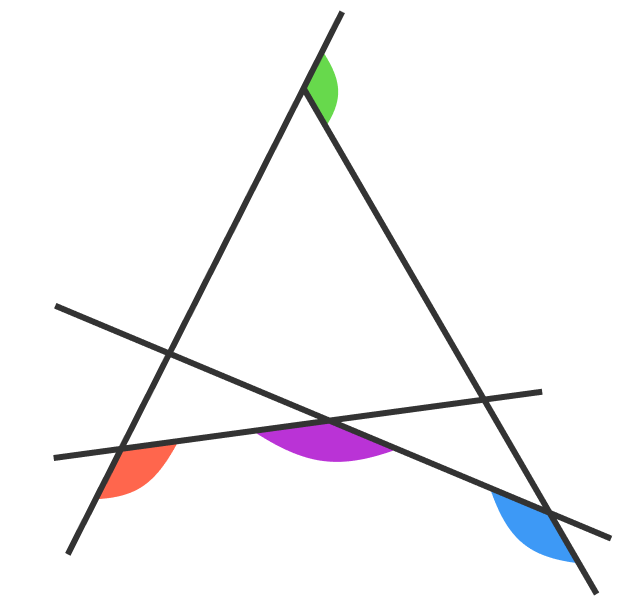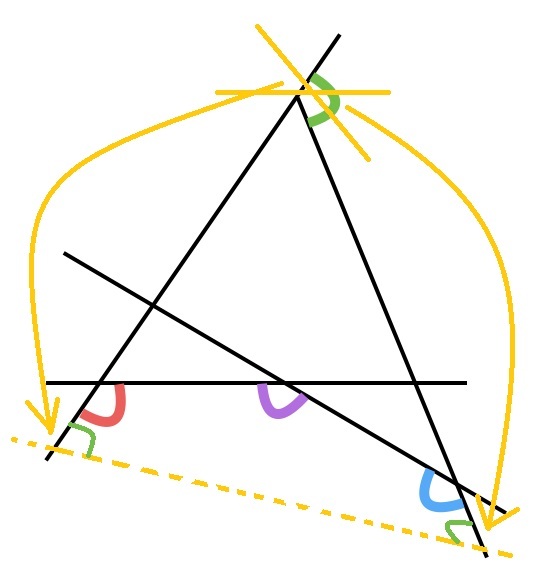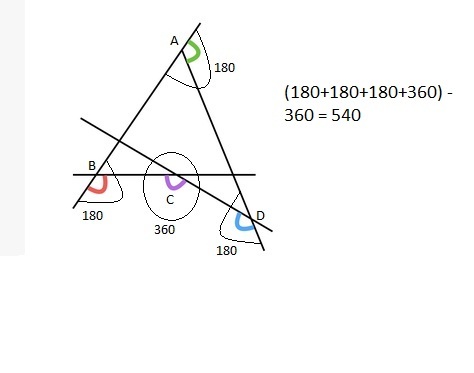Angles Sum

Find the sum (in degrees) of the four colored angles in the diagram.
This section requires Javascript.
You are seeing this because something didn't load right. We suggest you, (a) try
refreshing the page, (b) enabling javascript if it is disabled on your browser and,
finally, (c)
loading the
non-javascript version of this page
. We're sorry about the hassle.
5 solutions
There is a nice trick using a pencil, rotating the pencil every time we come across an angle. The final rotation of the pencil after going through all the angles is 5 4 0 ∘ which is our answer.
Very nicely done
Pretty neat. Congratulations
 after drawing the orange line you make a big triangle and five sides polygons the green angle can be converted to the opposite triangle interior angles to be the left two angles of the polygons.
after drawing the orange line you make a big triangle and five sides polygons the green angle can be converted to the opposite triangle interior angles to be the left two angles of the polygons.
the interior angles of the five sides polygons is 180(5-2) = 540
Very nice solution!
Wow! Such an indirect and elegant solution. Very nice imagination!

As ABCD is a quadrilateral.. then the sum of all(4) interior angles is (n - 2) 180=>(4 - 2) 180=360. Now the sum of GREEN, RED and BLUE angles and their supplementary angles is 180+180+180 and sum of VIOLET angle and its explementary angle is 360. Now (180+180+180+360) - 360{(4 - 2)*360)} = 540
ABCD is a quadrilateral not a rectangle.
Easiest method!!!
I have marked 2 more angles than shown in the question...
Sum of the angles of a triangle is 180°. ∴sum of exterior angles 1,2 and 6 is 360°
∴ ∠1+∠2+∠6=360° ...... 1
Similarily
∠4+∠5+∠3=360° ...... 2
∠3=180°-∠6 Using this in 2:
∠4+∠5+(180°-∠6)=360° .......3
Now adding 1 and 3 we get ∠1+∠2+∠6+∠4+∠5+(180°-∠6)=720°
⇒ ∠1+∠2+∠4+∠5+180°=720°
⇒ ∠1+∠2+∠4+∠5=540°
I don´t think the method I used is right in every case, but it was in this one. We know that every angle is greater than 90 but less than 180. So I multiplied 90 times 4 and 180 times 4. Then I summed the two results and divided by two.
There are quite a few nice approaches to this problem! Here's one of them, but can you find any others?